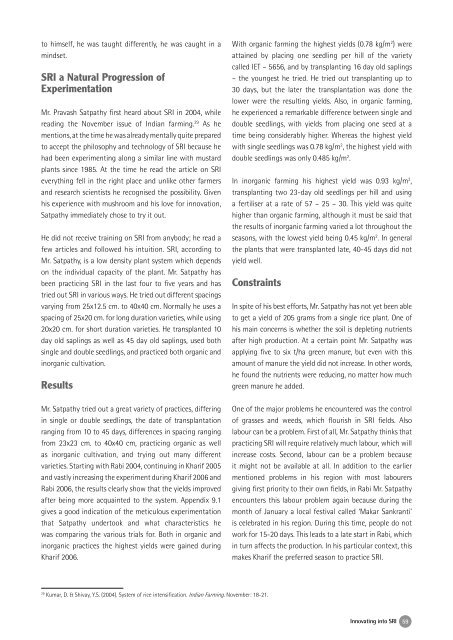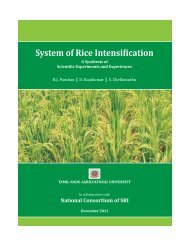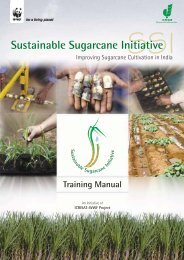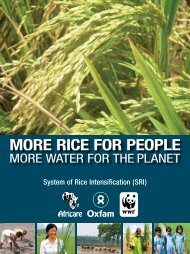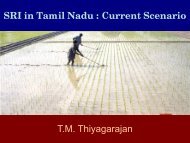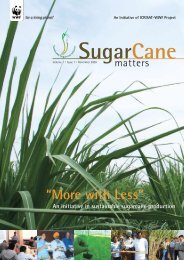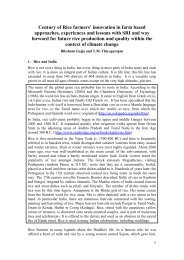SRI in Orissa - Cornell International Institute for Food, Agriculture ...
SRI in Orissa - Cornell International Institute for Food, Agriculture ...
SRI in Orissa - Cornell International Institute for Food, Agriculture ...
You also want an ePaper? Increase the reach of your titles
YUMPU automatically turns print PDFs into web optimized ePapers that Google loves.
to himself, he was taught differently, he was caught <strong>in</strong> a<br />
m<strong>in</strong>dset.<br />
<strong>SRI</strong> a Natural Progression of<br />
Experimentation<br />
Mr. Pravash Satpathy first heard about <strong>SRI</strong> <strong>in</strong> 2004, while<br />
read<strong>in</strong>g the November issue of Indian farm<strong>in</strong>g. 29 As he<br />
mentions, at the time he was already mentally quite prepared<br />
to accept the philosophy and technology of <strong>SRI</strong> because he<br />
had been experiment<strong>in</strong>g along a similar l<strong>in</strong>e with mustard<br />
plants s<strong>in</strong>ce 1985. At the time he read the article on <strong>SRI</strong><br />
everyth<strong>in</strong>g fell <strong>in</strong> the right place and unlike other farmers<br />
and research scientists he recognised the possibility. Given<br />
his experience with mushroom and his love <strong>for</strong> <strong>in</strong>novation,<br />
Satpathy immediately chose to try it out.<br />
He did not receive tra<strong>in</strong><strong>in</strong>g on <strong>SRI</strong> from anybody; he read a<br />
few articles and followed his <strong>in</strong>tuition. <strong>SRI</strong>, accord<strong>in</strong>g to<br />
Mr. Satpathy, is a low density plant system which depends<br />
on the <strong>in</strong>dividual capacity of the plant. Mr. Satpathy has<br />
been practic<strong>in</strong>g <strong>SRI</strong> <strong>in</strong> the last four to five years and has<br />
tried out <strong>SRI</strong> <strong>in</strong> various ways. He tried out different spac<strong>in</strong>gs<br />
vary<strong>in</strong>g from 25x12.5 cm. to 40x40 cm. Normally he uses a<br />
spac<strong>in</strong>g of 25x20 cm. <strong>for</strong> long duration varieties, while us<strong>in</strong>g<br />
20x20 cm. <strong>for</strong> short duration varieties. He transplanted 10<br />
day old sapl<strong>in</strong>gs as well as 45 day old sapl<strong>in</strong>gs, used both<br />
s<strong>in</strong>gle and double seedl<strong>in</strong>gs, and practiced both organic and<br />
<strong>in</strong>organic cultivation.<br />
Results<br />
Mr. Satpathy tried out a great variety of practices, differ<strong>in</strong>g<br />
<strong>in</strong> s<strong>in</strong>gle or double seedl<strong>in</strong>gs, the date of transplantation<br />
rang<strong>in</strong>g from 10 to 45 days, differences <strong>in</strong> spac<strong>in</strong>g rang<strong>in</strong>g<br />
from 23x23 cm. to 40x40 cm, practic<strong>in</strong>g organic as well<br />
as <strong>in</strong>organic cultivation, and try<strong>in</strong>g out many different<br />
varieties. Start<strong>in</strong>g with Rabi 2004, cont<strong>in</strong>u<strong>in</strong>g <strong>in</strong> Kharif 2005<br />
and vastly <strong>in</strong>creas<strong>in</strong>g the experiment dur<strong>in</strong>g Kharif 2006 and<br />
Rabi 2006, the results clearly show that the yields improved<br />
after be<strong>in</strong>g more acqua<strong>in</strong>ted to the system. Appendix 9.1<br />
gives a good <strong>in</strong>dication of the meticulous experimentation<br />
that Satpathy undertook and what characteristics he<br />
was compar<strong>in</strong>g the various trials <strong>for</strong>. Both <strong>in</strong> organic and<br />
<strong>in</strong>organic practices the highest yields were ga<strong>in</strong>ed dur<strong>in</strong>g<br />
Kharif 2006.<br />
With organic farm<strong>in</strong>g the highest yields (0.78 kg/m 2 ) were<br />
atta<strong>in</strong>ed by plac<strong>in</strong>g one seedl<strong>in</strong>g per hill of the variety<br />
called IET – 5656, and by transplant<strong>in</strong>g 16 day old sapl<strong>in</strong>gs<br />
– the youngest he tried. He tried out transplant<strong>in</strong>g up to<br />
30 days, but the later the transplantation was done the<br />
lower were the result<strong>in</strong>g yields. Also, <strong>in</strong> organic farm<strong>in</strong>g,<br />
he experienced a remarkable difference between s<strong>in</strong>gle and<br />
double seedl<strong>in</strong>gs, with yields from plac<strong>in</strong>g one seed at a<br />
time be<strong>in</strong>g considerably higher. Whereas the highest yield<br />
with s<strong>in</strong>gle seedl<strong>in</strong>gs was 0.78 kg/m 2 , the highest yield with<br />
double seedl<strong>in</strong>gs was only 0.485 kg/m 2 .<br />
In <strong>in</strong>organic farm<strong>in</strong>g his highest yield was 0.93 kg/m 2 ,<br />
transplant<strong>in</strong>g two 23-day old seedl<strong>in</strong>gs per hill and us<strong>in</strong>g<br />
a fertiliser at a rate of 57 – 25 – 30. This yield was quite<br />
higher than organic farm<strong>in</strong>g, although it must be said that<br />
the results of <strong>in</strong>organic farm<strong>in</strong>g varied a lot throughout the<br />
seasons, with the lowest yield be<strong>in</strong>g 0.45 kg/m 2 . In general<br />
the plants that were transplanted late, 40-45 days did not<br />
yield well.<br />
Constra<strong>in</strong>ts<br />
In spite of his best ef<strong>for</strong>ts, Mr. Satpathy has not yet been able<br />
to get a yield of 205 grams from a s<strong>in</strong>gle rice plant. One of<br />
his ma<strong>in</strong> concerns is whether the soil is deplet<strong>in</strong>g nutrients<br />
after high production. At a certa<strong>in</strong> po<strong>in</strong>t Mr. Satpathy was<br />
apply<strong>in</strong>g five to six t/ha green manure, but even with this<br />
amount of manure the yield did not <strong>in</strong>crease. In other words,<br />
he found the nutrients were reduc<strong>in</strong>g, no matter how much<br />
green manure he added.<br />
One of the major problems he encountered was the control<br />
of grasses and weeds, which flourish <strong>in</strong> <strong>SRI</strong> fields. Also<br />
labour can be a problem. First of all, Mr. Satpathy th<strong>in</strong>ks that<br />
practic<strong>in</strong>g <strong>SRI</strong> will require relatively much labour, which will<br />
<strong>in</strong>crease costs. Second, labour can be a problem because<br />
it might not be available at all. In addition to the earlier<br />
mentioned problems <strong>in</strong> his region with most labourers<br />
giv<strong>in</strong>g first priority to their own fields, <strong>in</strong> Rabi Mr. Satpathy<br />
encounters this labour problem aga<strong>in</strong> because dur<strong>in</strong>g the<br />
month of January a local festival called ‘Makar Sankranti’<br />
is celebrated <strong>in</strong> his region. Dur<strong>in</strong>g this time, people do not<br />
work <strong>for</strong> 15-20 days. This leads to a late start <strong>in</strong> Rabi, which<br />
<strong>in</strong> turn affects the production. In his particular context, this<br />
makes Kharif the preferred season to practice <strong>SRI</strong>.<br />
29<br />
Kumar, D. & Shivay, Y.S. (2004). System of rice <strong>in</strong>tensification. Indian Farm<strong>in</strong>g. November: 18-21.<br />
Innovat<strong>in</strong>g <strong>in</strong>to <strong>SRI</strong> 59


